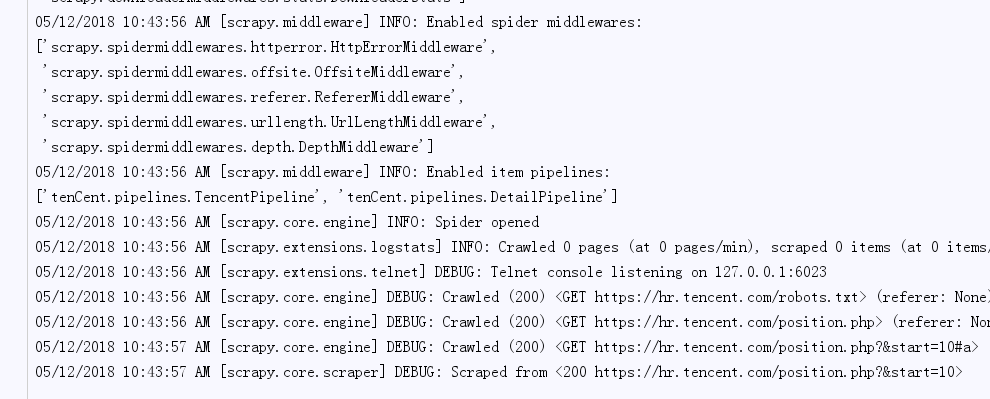Scrapy框架——CrawlSpider爬取某招聘信息网站
CrawlSpider
Scrapy框架中分两类爬虫,Spider类和CrawlSpider类。
它是Spider的派生类,Spider类的设计原则是只爬取start_url列表中的网页,
而CrawlSpider类定义了一些规则(rule)来提供跟进link的方便的机制,从爬取的网页中获取link并继续爬取的工作更适合。
创建项目指令:
scrapy startproject tenCent
CrawlSpider创建:
scrapy genspider -t crawl crawl_tencent "hr.tencent.com"
CrawlSpider继承于Spider类,除了继承过来的属性外(name、allow_domains),还提供了新的属性和方法:
LinkExtractor
from scrapy.linkextractors import LinkExtractor
LinkExtractor(allow=r'start=\d+')
通过实例化LinkExtractor提取链接
主要参数
allow:满足括号中“正则表达式”的值会被提取,如果为空,则全部匹配。 deny:与这个正则表达式(或正则表达式列表)不匹配的URL一定不提取。
rules
Rule(LinkExtractor(allow=r'start=\d+'), callback='parse_tencent', follow=True),
在rules中包含一个或多个Rule对象,每个Rule对爬取网站的动作定义了特定操作。
如果多个rule匹配了相同的链接,则根据规则在本集合中被定义的顺序,第一个会被使用
主要参数
link_extractor:是一个Link Extractor对象,用于定义需要提取的链接
callback: 从link_extractor中每获取到链接时,参数所指定的值作为回调函数,该回调函数接受一个response作为其第一个参数。 注意:当编写爬虫规则时,避免使用parse作为回调函数。由于CrawlSpider使用parse方法来实现其逻辑,如果覆盖了 parse方法,crawl spider将会运行失败。 follow:是一个布尔(boolean)值,指定了根据该规则从response提取的链接是否需要跟进。 如果callback为None,follow 默认设置为True ,否则默认为False。
使用CrawlSpider爬取信息
1.编写item文件
# -*- coding: utf-8 -*- # Define here the models for your scraped items
#
# See documentation in:
# https://doc.scrapy.org/en/latest/topics/items.html import scrapy class TencentItem(scrapy.Item):
# define the fields for your item here like:
# name = scrapy.Field()
# 职位名称
position_name = scrapy.Field()
# 详情链接
position_link = scrapy.Field()
# 职位类别
position_type = scrapy.Field()
# 职位人数
position_number = scrapy.Field()
# 职位地点
work_location = scrapy.Field()
# 发布时间
publish_times = scrapy.Field()
# 工作职责
position_duty = scrapy.Field()
# 工作要求
position_require = scrapy.Field() class DetailItem(scrapy.Item):
# 工作职责
position_duty = scrapy.Field()
# 工作要求
position_require = scrapy.Field()
2.编写crawlspider文件
# -*- coding: utf-8 -*-
import scrapy
from tenCent.items import TencentItem
from tenCent.items import DetailItem
from scrapy.linkextractors import LinkExtractor
from scrapy.spiders import CrawlSpider, Rule class CrawlTencentSpider(CrawlSpider):
name = 'crawl_tencent'
allowed_domains = ['hr.tencent.com']
start_urls = ['https://hr.tencent.com/position.php'] '''
rule LinkExtractor规则:
allow:根据正则表达式匹配链接
callback:回调函数
follow:是否提取跟进页(链接套链接)
'''
rules = (
Rule(LinkExtractor(allow=r'start=\d+'), callback='parse_tencent', follow=True),
# 从上面的规则传递下一个
Rule(LinkExtractor(allow=r'position_detail\.php\?id=\d+'), callback='parse_detail', follow=False),
) def parse_tencent(self, response):
print('start……')
node_list = response.xpath('//tr[@class="even"] | //tr[@class="odd"]')
# 选取所有标签tr 且class属性等于even或odd的元素
#i['domain_id'] = response.xpath('//input[@id="sid"]/@value').extract()
#i['name'] = response.xpath('//div[@id="name"]').extract()
#i['description'] = response.xpath('//div[@id="description"]').extract()
for node in node_list:
item = TencentItem()
item['position_name'] = node.xpath('./td[1]/a/text()').extract_first() # 获取第一个td标签下a标签的文本
item['position_link'] = node.xpath('./td[1]/a/@href').extract_first() # 获取第一个td标签下a标签href属性
item['position_type'] = node.xpath('./td[2]/text()').extract_first() # 获取第二个td标签下文本
item['position_number'] = node.xpath('./td[3]/text()').extract_first() # 获取第3个td标签下文本
item['work_location'] = node.xpath('./td[4]/text()').extract_first() # 获取第4个td标签下文本
item['publish_times'] = node.xpath('./td[5]/text()').extract_first() # 获取第5个td标签下文本 yield item def parse_detail(self, response):
item = DetailItem()
item['position_duty'] = ''.join(
response.xpath('//ul[@class="squareli"]')[0].xpath('./li/text()').extract()) # 转化为字符串
item['position_require'] = ''.join(
response.xpath('//ul[@class="squareli"]')[1].xpath('./li/text()').extract()) # 转化为字符串 yield item
3.建立pipeline文件
# -*- coding: utf-8 -*- # Define your item pipelines here
#
# Don't forget to add your pipeline to the ITEM_PIPELINES setting
# See: https://doc.scrapy.org/en/latest/topics/item-pipeline.html import json
from .items import TencentItem
from .items import DetailItem class TencentPipeline(object):
def open_spider(self, spider):
"""
# spider (Spider 对象) – 被开启的spider
# 可选实现,当spider被开启时,这个方法被调用。
:param spider:
:return:
"""
self.file = open('tencent.json', 'w', encoding='utf-8')
json_header = '{ "tencent_info":['
self.count = 0
self.file.write(json_header) # 保存到文件 def close_spider(self, spider):
"""
# spider (Spider 对象) – 被关闭的spider
# 可选实现,当spider被关闭时,这个方法被调用
:param spider:
:return:
"""
json_tail = '] }'
self.file.seek(self.file.tell() - 1) # 定位到最后一个逗号
self.file.truncate() # 截断后面的字符
self.file.write(json_tail) # 添加终止符保存到文件
self.file.close() def process_item(self, item, spider):
"""
# item (Item 对象) – 被爬取的item
# spider (Spider 对象) – 爬取该item的spider
# 这个方法必须实现,每个item pipeline组件都需要调用该方法,
# 这个方法必须返回一个 Item 对象,被丢弃的item将不会被之后的pipeline组件所处理。 :param item:
:param spider:
:return:
"""
# print('item=',dict(item)) if isinstance(item, TencentItem):
print('--'*20)
content = json.dumps(dict(item), ensure_ascii=False, indent=2) + "," # 字典转换json字符串
self.count += 1
print('content', self.count)
self.file.write(content) # 保存到文件
'''
return item后,item会根据优先级
传递到下一个管道DetailPipeline处理
此段代码说明当实例不属于TencentItem时,放弃存储json,
直接传递到下一个管道处理
return放在if外面,如果写在if里面item在不属于TencentItem实例后,
item会终止传递,造成detail数据丢失
'''
return item class DetailPipeline(object):
def open_spider(self, spider):
"""
# spider (Spider 对象) – 被开启的spider
# 可选实现,当spider被开启时,这个方法被调用。
:param spider:
:return:
"""
self.file = open('detail.json', 'w', encoding='utf-8')
json_header = '{ "detail_info":['
self.count = 0
self.file.write(json_header) # 保存到文件 def close_spider(self, spider):
"""
# spider (Spider 对象) – 被关闭的spider
# 可选实现,当spider被关闭时,这个方法被调用
:param spider:
:return:
"""
json_tail = '] }'
self.file.seek(self.file.tell() - 1) # 定位到最后一个逗号
self.file.truncate() # 截断后面的字符
self.file.write(json_tail) # 添加终止符保存到文件
self.file.close() def process_item(self, item, spider):
"""
# item (Item 对象) – 被爬取的item
# spider (Spider 对象) – 爬取该item的spider
# 这个方法必须实现,每个item pipeline组件都需要调用该方法,
# 这个方法必须返回一个 Item 对象,被丢弃的item将不会被之后的pipeline组件所处理。 :param item:
:param spider:
:return:
"""
# print('item=',dict(item)) if isinstance(item, DetailItem):
'''
得到item,判断item实例属于DetailItem,存储json文件
如果不属于,直接return item到下一个管道
'''
print('**' * 30)
content = json.dumps(dict(item), ensure_ascii=False, indent=2) + "," # 字典转换json字符串
self.count += 1
print('content', self.count)
self.file.write(content) # 保存到文件
return item
4.设置settiing
#1、项目名称,默认的USER_AGENT由它来构成,也作为日志记录的日志名
BOT_NAME = 'tenCent'
# 2、爬虫应用路径
SPIDER_MODULES = ['tenCent.spiders']
NEWSPIDER_MODULE = 'tenCent.spiders' # Crawl responsibly by identifying yourself (and your website) on the user-agent
USER_AGENT = '"User-Agent":"Mozilla/5.0 (Windows NT 6.1; Win64; x64) AppleWebKit/537.36 (KHTML, like Gecko) Chrome/63.0.3239.132 Safari/537.36"' # 头部信息,反爬 # Obey robots.txt rules
ROBOTSTXT_OBEY = True # log日志
LOG_FILE = 'tencent.log'
LOG_LEVEL = 'DEBUG'
LOG_ENCODING = 'utf-8'
LOG_DATEFORMAT='%m/%d/%Y %H:%M:%S %p' ITEM_PIPELINES = {
'tenCent.pipelines.TencentPipeline': 300,
'tenCent.pipelines.DetailPipeline':400
}
5.执行程序
scrapy crawl crawl_tencent
tencent.log

tencent.json

detail.json

Scrapy框架——CrawlSpider爬取某招聘信息网站的更多相关文章
- 爬虫框架之Scrapy——爬取某招聘信息网站
案例1:爬取内容存储为一个文件 1.建立项目 C:\pythonStudy\ScrapyProject>scrapy startproject tenCent New Scrapy projec ...
- 爬取拉勾网招聘信息并使用xlwt存入Excel
xlwt 1.3.0 xlwt 文档 xlrd 1.1.0 python操作excel之xlrd 1.Python模块介绍 - xlwt ,什么是xlwt? Python语言中,写入Excel文件的扩 ...
- Scrapy实战篇(七)之Scrapy配合Selenium爬取京东商城信息(下)
之前我们使用了selenium加Firefox作为下载中间件来实现爬取京东的商品信息.但是在大规模的爬取的时候,Firefox消耗资源比较多,因此我们希望换一种资源消耗更小的方法来爬取相关的信息. 下 ...
- Python爬取拉勾网招聘信息并写入Excel
这个是我想爬取的链接:http://www.lagou.com/zhaopin/Python/?labelWords=label 页面显示如下: 在Chrome浏览器中审查元素,找到对应的链接: 然后 ...
- python-scrapy爬虫框架爬取拉勾网招聘信息
本文实例为爬取拉勾网上的python相关的职位信息, 这些信息在职位详情页上, 如职位名, 薪资, 公司名等等. 分析思路 分析查询结果页 在拉勾网搜索框中搜索'python'关键字, 在浏览器地址栏 ...
- python之scrapy爬取jingdong招聘信息到mysql数据库
1.创建工程 scrapy startproject jd 2.创建项目 scrapy genspider jingdong 3.安装pymysql pip install pymysql 4.set ...
- pyspider爬虫框架webui简介-爬取阿里招聘信息
命令行输入pyspider开启pyspider 浏览器打开http://localhost:5000/ group表示组名,几个项目可以同一个组名,方便管理,当组名修改为delete时,项目会在一天后 ...
- python scrapy爬取前程无忧招聘信息
使用scrapy框架之前,使用以下命令下载库: pip install scrapy -i https://pypi.tuna.tsinghua.edu.cn/simple 1.创建项目文件夹 scr ...
- scrapy框架 + selenium 爬取豆瓣电影top250......
废话不说,直接上代码..... 目录结构 items.py import scrapy class DoubanCrawlerItem(scrapy.Item): # 电影名称 movieName = ...
随机推荐
- (转)2017年12月宋华教授携IBM中国研究院、猪八戒网、中航信托、33复杂美共同论道智慧供应链金融
今年10月,国务院发布的<关于积极推进供应链创新与应用的指导意见>,不仅强调了发展服务型制造的重要性,同时也指出要积极稳妥发展供应链金融,推动供应链金融服务实体经济,鼓励商业银行.供应链核 ...
- SWIFT中切換UIContainerView內的Controller
如下,一个UIContainerView内切换两个Controller,当点击登录的时候UIContainerView的视图为LoginController,当点击登记的时候UIContainerVi ...
- Magento如何设置产品的打折或者优惠价格
促销是商家的必备武器,手段可以说是花样繁多.其中最有效最具吸引力的就是优惠券了.那么在Magento中如何添加优惠券呢? 修改位置:后台--促销--购物车价格规则 1.点击右上角的 添加新规则 按钮. ...
- python可视化爬虫实现“京东试用”批量申请
介绍: 环境:chromedriver 2.41.578700+ selenuim3.14.0 过程: 1.打开京东主页 2.登录京东 3.打开京东试用页面 4.获取商品列表 5.自动申请试用(该商品 ...
- ubuntu16.04 中文输入法
https://blog.csdn.net/qq_21792169/article/details/53152700 在主文件夹目录即home目录,按快捷键Ctrl+H(显示隐藏文件),看到的.bas ...
- 转:如何解决VC "应用程序无法启动,因为应用程序的并行配置不正确 sxstrace.exe"问题
如何解决VC "应用程序无法启动,因为应用程序的并行配置不正确 sxstrace.exe"问题 引用链接 http://blog.csdn.net/pizi0475/artic ...
- CodeForces - 285E: Positions in Permutations(DP+组合数+容斥)
Permutation p is an ordered set of integers p1, p2, ..., pn, consisting of n distinct positive in ...
- MyBatis-动态SQL的if、choose、when、otherwise、trim、where、set、foreach使用(各种标签详解), 以及实体间关系配置
比较全的文档:https://www.cnblogs.com/zhizhao/p/7808880.html 或 https://blog.csdn.net/zhll3377/article/detai ...
- test20181005 迷宫
题意 分析 时间复杂度里的n,m写反了. 出题人很有举一反三的精神. 代码 我的代码常数巨大,加了各种优化后开O3最慢点都要0.9s. #include<cstdlib> #include ...
- sql serve 创建序列
Oracle中有sequence的功能,SQL Server类似的功能使用Identity列实现,但是有很大的局限性. 在2012中,微软终于增加了 sequence 对象,功能和性能都有了很大的提高 ...
